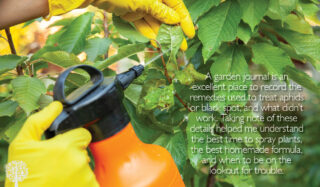Taking Notes: Journals Are Essential To Thriving Gardens
Each garden has its own specific needs, quirks, and growth cycle. Keeping a journal of what has and hasn’t worked for my garden has helped me grow healthier plants and understand the micro-climate, ecosystem, and soil specific to my space.
There are no rules on how to organize or maintain a garden journal. It can be a placeholder for seed packets and plant tags or a compilation of valuable tips. It can be a log on your phone or laptop that’s added to whenever the urge strikes or a large binder you write in daily.
Whether a first-time gardener or caretaker of a large backyard or small urban patio, a garden journal is a place to be reminded of the history of your garden, to dream, and to appreciate Mother Nature’s wonder.
Keeping track of a plant’s bloom cycle helps maintain color in the garden from spring to fall.


Some plants are very thirsty; others crave a lot of compost. Recording this information in a garden journal makes it easy to remember (because you will forget).
I have pages of garden outlines showing me where specific plants thrive. Drawing a garden map is a great way to be creative and plan crop placement, rotations, or color schemes.
-
Treating Infestations and Disease
A garden journal is an excellent place to record the remedies used to treat aphids or black spot, and what didn’t work. Taking note of these details helped me understand the best time to spray plants, the best homemade formula, and when to be on the lookout for trouble.


Every month, different things happen in the garden. It can be a full-time job keeping track. A garden journal is a great place to keep those schedules of when to prune the apple tree, divide perennials, or when the best time is to plant tomatoes.
Every gardener has their favorite plant websites or garden centers that they turn to for advice or new information about how to keep their garden thriving. Keeping a list in your garden journal is a great reference guide. I even have a climate zone map tucked into the front cover.
Keeping track of pollinators such as bees and hummingbirds in the garden will help you know if your selections and design are attractive to them.
My garden has a squirrel problem, but my neighbors live squirrel-free. By keeping track, I deciphered their patterns, noted the plants they liked, and responded by not planting them or placing chicken wire around the most vulnerable.


A garden journal can be whatever you want it to be. Perhaps it’s a wish list of plants to buy, a history of what was, a tips and tricks reference guide, or just a place to record the sights, sounds, and smells you experience in the garden. It tells a story unique to you and your garden; you are the author.




